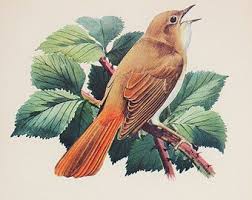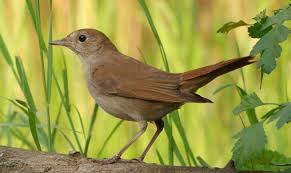by DJ Featherton

One of my college majors was in English literature. I loved reading all that heavy-duty prose and poetry of every classic English bard from Shelley to Milton to Shakespeare. Almost all of these great authors and artists included the Nightingale in their works. John Keats wrote “Ode to the Nightingale,” and Homer evokes the Nightingale in the “Odyssey.” Don’t forget T.S. Elliot, Virgil, Chaucer, Beethoven, and the list goes on forever.
There was always some romantic, melancholy poet finding peace and reason from the beauty of the nightingale’s melodic song outside his window late at night. Irony being, even as a birder, I didn’t know anything about the Nightingale for years. I didn’t even know if the bird was real, or just a handy literary device used by poets. As it turned out, only a few minutes of research let me know the Nightingale is real and is still singing his beautiful song late into the night. Oh, to the Nightingale!
More irony! That loud and beautifully melodic song heard late at night that has fed the imagination of so many great authors and thinkers is really just a very common and indistinct little brown bird. The Nightingale was once considered a thrush, later a chat, and is now classified as an Old World flycatcher. Their back and wings are a plain rufus brown, and their tail is a light reddish. The chin and underparts are a buffy white, and the male and female look alike. These common birds range across Europe, into Asia, and migrate to Sub-Saharan Africa. The Ukraine has adapted the Nightingale as it’s national bird. Although the common Nightingale is not found in the Americas, there are several other Nightingale species that are.

The word “Nightingale” dates back to at least 1066, and in old English is ‘niht’ for night, and ‘galan’ for sing. So, a good singer is a nihtgalan, or, nightingale. The unusually beautiful song of the Nightingale can be heard in the day, but is most noticeable at night when other birds and activities are quiet. Why do they sing at night? They’re calling for a mate, of course, even in the lonely hours of the night. I don’t know if the Nightingale is aware of his influence on late night writers, but here’s what Shelley said in his famed “A Defense for Poetry”:
“A Poet is a nightingale who sits in darkness, and sings to cheer its own solitude with sweet sounds; his auditors are as men entranced by the melody of an unseen musician, who feel that they are moved and softened, yet know not whence or why.” Percy Bysshe Shelley

Considering this, I can’t help but share a lengthy list of authors and artists that over so many years, right up to today, were influenced by the song of the Nightingale. How did this little, ordinary, brown, Old World flycatcher with a great big beautiful night time song effect generations of our greatest artists? Maybe it’s because the nightingale’s song has been described as one of the most beautiful sounds in nature. Have fun with this list. It’s not complete, but I know you’ll be impressed with all you recognize. Oh, to the Nightingale!
- The Aēdōn (Ancient Greek: Ἀηδών, “Nightingale”) is a minor character in Aristophanes‘s 414 BC Attic comedy The Birds.
- Philomela is transformed into a nightingale, according to Metamorphoses (book IV) of Ovid.
- The love of the nightingale (a conventional cultural substitution for the Persian bulbul) for the rose is widely used as a metaphor for the poet’s love for the beloved and the worshiper’s love for God in classical Persian, Urdu and Turkish poetry.[25]
- “The Owl and the Nightingale” (12th or 13th century) is a Middle English poem about an argument between these two birds.
- “When The Nightingale Sings” is a Middle English love poem, extolling the beauty and lost love of an unknown maiden.
- “Laüstic“, a lai by French poet Marie de France from High Middle Ages (1100-1300)
- John Milton‘s sonnet “To the Nightingale” (1632–33) contrasts the symbolism of the nightingale as a bird for lovers, with the cuckoo as the bird that called when wives were unfaithful to (or “cuckolded”) their husbands.
- Samuel Taylor Coleridge‘s “The Nightingale: A Conversation Poem“, printed in 1798, disputes the traditional idea that nightingales are connected to the idea of melancholy.
- Ludwig van Beethoven‘s Symphony No. 6 (1808), the “Pastoral Symphony”, includes in its second movement flute imitations of nightingale calls.
- Franz Liszt featured the nightingale’s song in the Mephisto Waltzes No. 1.
- John Keats‘ “Ode to a Nightingale” (1819) was described by Edmund Clarence Stedman as “one of our shorter English lyrics that still seems to me… the nearest to perfection, the one I would surrender last of all”[26] and by Algernon Charles Swinburne as “one of the final masterpieces of human work in all time and for all ages”.[27]
- The beauty of the nightingale’s song is a theme in Hans Christian Andersen‘s story “The Nightingale” from 1843.[28]
- A recording of nightingale song is included, as directed by the score, in “The Pines of Janiculum”, the third movement of Ottorino Respighi‘s 1924 symphonic poem Pines of Rome (Pini di Roma).
- Igor Stravinsky based his first opera, The Nightingale (1914), on the Hans Christian Andersen story and later prepared a symphonic poem, The Song of the Nightingale (1917), using music from the opera.
- In 1915, Joseph Lamb wrote a rag called “Ragtime Nightingale” that was intended to imitate the nightingale calls.[29]
- “A Nightingale Sang in Berkeley Square” (1939) was one of the most popular songs in Britain during World War II. In 2004, the song featured in an episode of series 2 of the Channel 4 sitcom Peep Show and in 2019, it featured as the closing song of the Amazon/BBC miniseries Good Omens.
- Both Terry Pratchett and Neil Gaiman‘s novel Good Omens and the aforementioned miniseries adaptation joke that, “…while they were eating, for the first time ever, a nightingale (sang/actually did sing) in Berkeley Square. Nobody heard it over the noise of the traffic, but it was there, right enough.”
- A nightingale is depicted on the reverse of the Croatian 1 kuna coin, minted since 1993.[30]
- Nightingale was an inspiration of the creation of a Korean court solo dance Chunaengjeon (춘앵전). The dance initially was performed by male dance of the court of Joseon Dynasty, Mudong.
- In Chapter 13 of Mary Shelley‘s Frankenstein, the monster compares Safie’s singing voice to that of a “nightingale in the woods”.
- Manfred Mann’s Earth Band‘s sixth album, 1975’s Nightingales & Bombers, took its title from a World War II naturalist’s recording of a nightingale singing in a garden as warplanes flew overhead. The recording is feature in a song on the album.
- The song of the nightingale is one of the main elements in the 2019 single “Let Nature Sing“.
from Wikipedia